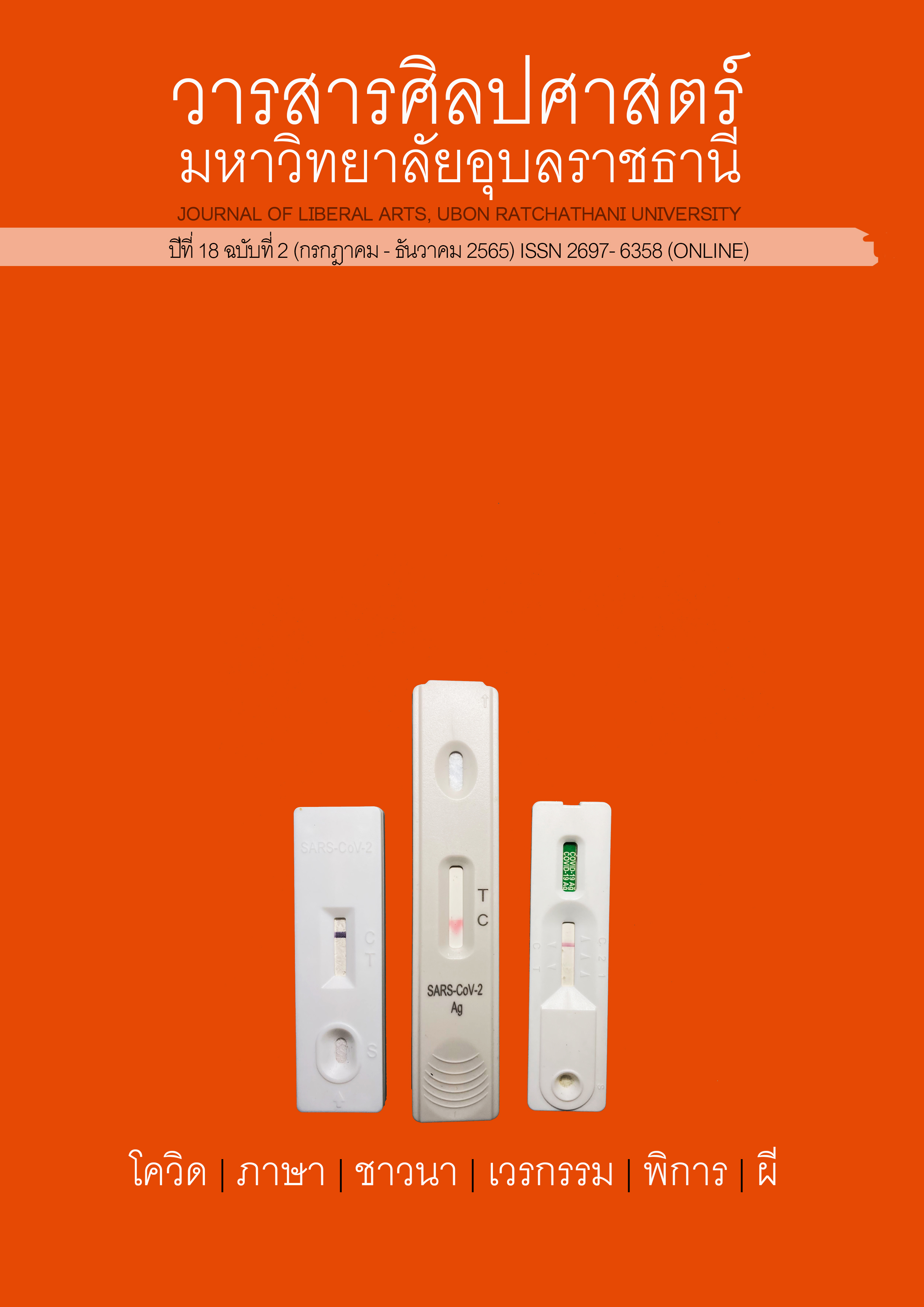“ผี”กับความหมายของคนตายในใจคนเป็น: พลังของการยังคงอยู่
Main Article Content
บทคัดย่อ
สิ่งเหนือธรรมชาติที่ไม่อาจอธิบายได้ หรือประสบการณ์เห็น “ผี” ที่เชื่อมโยงกับโลกหลังความตายซึ่งเป็นสัจธรรมของมนุษย์นั้น ชวนให้เราตั้งคำถามถึงคุณค่าและความหมายในการมีอยู่ของพวกเขา โดยเฉพาะการที่พวกเขายังคงสายสัมพันธ์ในความทรงจำของคนใกล้ชิดและสังคมรอบข้าง บทความชิ้นนี้ ทำการวิเคราะห์หน้าที่สำคัญของ “ผี” โดยเฉพาะคุณค่าจากการให้ความหมายของคนเป็นต่อประสบการณ์ลี้ลับ โดยศึกษาจากกรณีทั้ง 3 กรณี สรุปได้ 3 ประเด็นสำคัญ ดังนี้ 1) “ผี” ช่วยสร้างพลังให้คนที่ยังอยู่ ด้วยการใช้ชีวิตร่วมกันในสถานะที่ต่างออกไปจากตอนมีชีวิต และถูกให้ความหมายต่าง ๆ กัน ตามแต่การตีความและรับรู้ของแต่ละคนในแต่ละบริบทวัฒนธรรม 2) ประสบการณ์กับ “ผี” มิใช่เป็นประสบการณ์เฉพาะตัวเสมอไป แต่เป็นประสบการณ์ร่วมของคนในพื้นที่นั้นด้วย และการสะสมประสบการณ์ร่วมนี้ได้บ่มเพาะให้กลายเป็นความเชื่อที่ฝังในหัวใจของคนในท้องถิ่น 3) การรับรู้และยอมรับได้ถึง “ผี” แสดงให้เห็นว่า ชีวิตในสังคมทุกวันนี้ ยังมีการสื่อสารระหว่าง 2 โลกอยู่เสมอแม้จะอยู่ในหลักวิทยาศาสตร์เพียงใดก็ตาม สิ่งเหล่านี้ นำไปสู่การเปิดพื้นที่การรับรู้และยอมรับในการดำรงอยู่ของสายสัมพันธ์ระหว่างกันทั้งเพื่อคนที่อยู่และคนที่จากไป
Downloads
Article Details

อนุญาตภายใต้เงื่อนไข Creative Commons Attribution-NonCommercial-NoDerivatives 4.0 International License.
เอกสารอ้างอิง
Archavanitkul, K. & Thongthai, W. (2006). Death Situation: A Reflection on Population Stability. [in Thai]. Bangkok: Plan Printing.
Bauman, Z. (1992). Mortality, Immortality and Other Life Strategies. California: Stanford University Press.
Bookbinder, M. & McHugh, M. E. (2010). Symptom Management in Palliative Care and End of Life Care. Nursing Clinics of North America, 45 (3), 271-327.
Bowlby, J. (1969). Attachment and Loss. Vol. I Attachment. London: Hogarth Press.
Chungsathiansap, K. et al. (2007). Culture of Death and End-of-Life: The Guideline of Social Dimension of Learning in the Hospice Care. [in Thai]. Nonthaburi: Society and Health Institute.
Chutaraphatphon, D. (n.d.). Delirium and Agitation in Terminally ill patient. [in Thai]. https://www.rama.mahidol.ac.th/fammed/th/palliativecare/knowledges/doctorpalliative8th
Duangwiset, N. (2022). Anthropology and the Studies of Ghost and Paranormal Activity. [in Thai]. https://www.sac.or.th/portal/th/article/detail/304
Jankham, W. & Sriprapandh, K. (2017) Comparative Analysis of Meaning Regarding Ghost in Kon Ouad Pee Television Program with the Belief in Ghosts in Thai Society. [in Thai]. Journal of Mass Communication, Chiang Mai University, 5 (2), 46-70.
Kim, V. (2020). Virtual Reality, Real Grief. https://slate.com/technology/2020/05/meeting-you-virtual-reality-documentary-mbc.html
Kübler-Ross, E. (1969). On Death and Dying. New York: Macmillan.
Kübler-Ross, E. & Kessler, D. (2005). On Grief and Grieving: Finding the Meaning of Grief Through the Five Stages of Loss. New York: Simon and Schuster.
Main, M., Kaplan, N. & Cassidy, J. (1985). Security in Infancy, Childhood, and Adulthood: A Move to the Level of Representation. Monographs of the Society for Research in Child Development, 50 (1/2), 66-104.
O'Connell, R. (2020). How Japan Healed My Heart: Finding Solace at Tokyo’s Zojoji Temple after a Devastating Loss. https://www.worldnomads.com/stories/transformation/how-japan-healed-my-heart
Rodpal, J. (2006). Good Death: Perspectives from Thai Buddhist Elderly. [in Thai]. Master’s thesis, Chulalongkorn University.
Pormkaew, P. (2001). Beliefs and Rituals Related to Ghost Belief, and the Social Role of Southern Thai Buddhists. [in Thai]. Bangkok: Office of the National Culture Commission (ONCC), Ministry of Education.
Tillich, P. (1959). The Eternal Now. In Feifel, H., editor. The Meaning of Death. (p. 30-38). New York: McGraw-Hill.
Weiss, B. L. (1997). Only Love is Real: The Story of Soulmates Reunited. London: Piatkus.
Yasuka. (2018). The Sad Truth About Jizo Bosatsu Statues. https://www.kcpinternational.com/2018/01/sad-truth-jizo-bosatsu-statues/#:~:text=The%20Jizo%20statues%20represent%20protected,shades%20of%20vermilion%20or%20ruby


